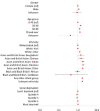Ethnic variation in outcome of people hospitalised during the first COVID-19 epidemic wave in Wales (UK): an analysis of national surveillance data using Onomap, a name-based ethnicity classification tool
- PMID: 34408047
- PMCID: PMC8375451
- DOI: 10.1136/bmjopen-2020-048335
Ethnic variation in outcome of people hospitalised during the first COVID-19 epidemic wave in Wales (UK): an analysis of national surveillance data using Onomap, a name-based ethnicity classification tool
Abstract
Objective: To identify ethnic differences in proportion positive for SARS-CoV-2, and proportion hospitalised, proportion admitted to intensive care and proportion died in hospital with COVID-19 during the first epidemic wave in Wales.
Design: Descriptive analysis of 76 503 SARS-CoV-2 tests carried out in Wales to 31 May 2020. Cohort study of 4046 individuals hospitalised with confirmed COVID-19 between 1 March and 31 May. In both analyses, ethnicity was assigned using a name-based classifier.
Setting: Wales (UK).
Primary and secondary outcomes: Admission to an intensive care unit following hospitalisation with a positive SARS-CoV-2 PCR test. Death within 28 days of a positive SARS-CoV-2 PCR test.
Results: Using a name-based ethnicity classifier, we found a higher proportion of black, Asian and ethnic minority people tested for SARS-CoV-2 by PCR tested positive, compared with those classified as white. Hospitalised black, Asian and minority ethnic cases were younger (median age 53 compared with 76 years; p<0.01) and more likely to be admitted to intensive care. Bangladeshi (adjusted OR (aOR): 9.80, 95% CI 1.21 to 79.40) and 'white - other than British or Irish' (aOR: 1.99, 95% CI 1.15 to 3.44) ethnic groups were most likely to be admitted to intensive care unit. In Wales, older age (aOR for over 70 years: 10.29, 95% CI 6.78 to 15.64) and male gender (aOR: 1.38, 95% CI 1.19 to 1.59), but not ethnicity, were associated with death in hospitalised patients.
Conclusions: This study adds to the growing evidence that ethnic minorities are disproportionately affected by COVID-19. During the first COVID-19 epidemic wave in Wales, although ethnic minority populations were less likely to be tested and less likely to be hospitalised, those that did attend hospital were younger and more likely to be admitted to intensive care. Primary, secondary and tertiary COVID-19 prevention should target ethnic minority communities in Wales.
Keywords: COVID-19; epidemiology; public health.
© Author(s) (or their employer(s)) 2021. Re-use permitted under CC BY-NC. No commercial re-use. See rights and permissions. Published by BMJ.
Conflict of interest statement
Competing interests: Paul Longley is Director of Publicprofiler Ltd.
Figures


Similar articles
-
Ethnic differences in SARS-CoV-2 infection and COVID-19-related hospitalisation, intensive care unit admission, and death in 17 million adults in England: an observational cohort study using the OpenSAFELY platform.Lancet. 2021 May 8;397(10286):1711-1724. doi: 10.1016/S0140-6736(21)00634-6. Epub 2021 Apr 30. Lancet. 2021. PMID: 33939953 Free PMC article.
-
Ethnic minority status as social determinant for COVID-19 infection, hospitalisation, severity, ICU admission and deaths in the early phase of the pandemic: a meta-analysis.BMJ Glob Health. 2021 Nov;6(11):e007433. doi: 10.1136/bmjgh-2021-007433. BMJ Glob Health. 2021. PMID: 34740916 Free PMC article.
-
Racial and Ethnic Disparities in Rates of COVID-19-Associated Hospitalization, Intensive Care Unit Admission, and In-Hospital Death in the United States From March 2020 to February 2021.JAMA Netw Open. 2021 Oct 1;4(10):e2130479. doi: 10.1001/jamanetworkopen.2021.30479. JAMA Netw Open. 2021. PMID: 34673962 Free PMC article.
-
Risk factors associated with SARS-CoV-2 infection in a multiethnic cohort of United Kingdom healthcare workers (UK-REACH): A cross-sectional analysis.PLoS Med. 2022 May 26;19(5):e1004015. doi: 10.1371/journal.pmed.1004015. eCollection 2022 May. PLoS Med. 2022. PMID: 35617423 Free PMC article.
-
The influence of gender and ethnicity on facemasks and respiratory protective equipment fit: a systematic review and meta-analysis.BMJ Glob Health. 2021 Nov;6(11):e005537. doi: 10.1136/bmjgh-2021-005537. BMJ Glob Health. 2021. PMID: 34764145 Free PMC article.
Cited by
-
Exploring ethnicity dynamics in Wales: a longitudinal population-scale linked data study and development of a harmonised ethnicity spine.BMJ Open. 2024 Aug 3;14(8):e077675. doi: 10.1136/bmjopen-2023-077675. BMJ Open. 2024. PMID: 39097317 Free PMC article.
-
Time varying association between deprivation, ethnicity and SARS-CoV-2 infections in England: A population-based ecological study.Lancet Reg Health Eur. 2022 Apr;15:100322. doi: 10.1016/j.lanepe.2022.100322. Epub 2022 Feb 13. Lancet Reg Health Eur. 2022. PMID: 35187517 Free PMC article.
-
Migration background and COVID-19 related intensive care unit admission and mortality in the Netherlands: A cohort study.PLoS One. 2023 Apr 5;18(4):e0284036. doi: 10.1371/journal.pone.0284036. eCollection 2023. PLoS One. 2023. PMID: 37018329 Free PMC article.
-
Ethnic inequalities in COVID-19 infection, hospitalisation, intensive care admission, and death: a global systematic review and meta-analysis of over 200 million study participants.EClinicalMedicine. 2023 Mar;57:101877. doi: 10.1016/j.eclinm.2023.101877. Epub 2023 Mar 6. EClinicalMedicine. 2023. PMID: 36969795 Free PMC article.
-
Impact of influenza vaccination on GP-diagnosed COVID-19 and all-cause mortality: a Dutch cohort study.BMJ Open. 2022 Sep 22;12(9):e061727. doi: 10.1136/bmjopen-2022-061727. BMJ Open. 2022. PMID: 36137620 Free PMC article.
References
-
- ICNARC – reports, 2020. Available: https://www.icnarc.org/Our-Audit/Audits/Cmp/Reports [Accessed 14 Jun 2020].
-
- Guardian . Ethnic minorities dying of Covid-19 at higher rate, analysis shows, 2020.
-
- Cifuentes R. All in it together? the impact of coronavirus on BamE people in Wales. Bevan Foundation, 2020.
MeSH terms
LinkOut - more resources
Full Text Sources
Medical
Miscellaneous
